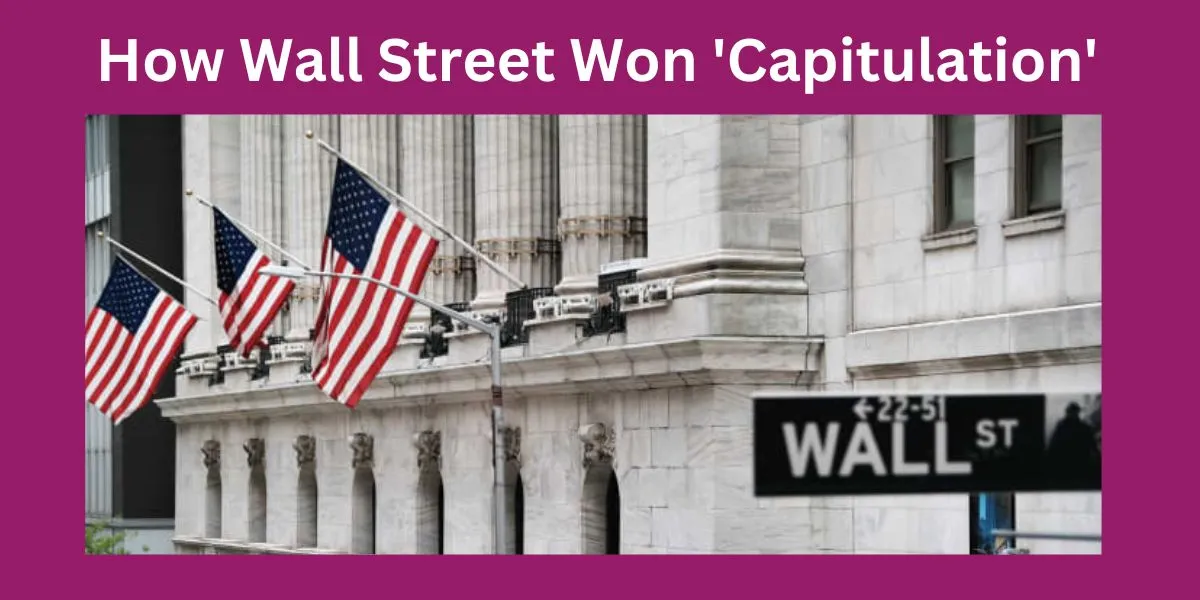The relationship between Wall Street and the U.S. Federal Reserve has always been a complex dance, one filled with tension, power struggles, and occasional cooperation. One of the most recent points of contention? New banking regulations. So, how exactly did Wall Street win over the Federal Reserve when it came to these new rules? Let’s dive in to understand the nuances of this financial tug-of-war.
The Background: What Are These New Bank Rules?
The U.S. Federal Reserve, as the nation’s central bank, is responsible for setting rules and regulations that govern the banking industry. These rules are designed to ensure the safety of the financial system, promote stability, and protect consumers. Over the years, as the economy has evolved and financial crises have occurred, the Fed has had to adjust these regulations.
But here’s the kicker: Wall Street, with its immense financial power, often finds itself at odds with the Fed’s regulations. Why? Because tighter regulations often mean less freedom for banks to take risks, which in turn can hurt their profitability. In the past few years, the Federal Reserve has been working on new rules aimed at further tightening oversight of banks, particularly in the wake of the 2008 financial crisis.
What Sparked the Debate?
In recent years, the Fed proposed several new rules that were seen as more stringent than what many banks were comfortable with. These rules included higher capital requirements and tighter oversight of how banks manage their assets. The goal? To prevent another financial crisis like the one in 2008. But, as you might imagine, Wall Street wasn’t thrilled.
Wall Street’s major players argued that these new rules would stifle economic growth by making it harder for banks to lend. They also claimed that the regulations would make U.S. banks less competitive on a global scale. This was when the battle began. Wall Street was determined to fight these rules, and it used all the influence it could muster.
The Role of Lobbying
Let’s be real: lobbying is a powerful tool in Washington, D.C. And when it comes to financial regulations, Wall Street knows how to play the game.
How Does Lobbying Work?
Lobbying is essentially when individuals or organizations try to influence lawmakers and regulators to make decisions that benefit their interests. Wall Street has deep pockets and connections, and it’s no secret that big banks and financial institutions have some of the most well-connected lobbyists in Washington.
Wall Street’s Strategy
Wall Street’s approach was simple yet effective. It used its vast resources to push back against the Federal Reserve’s proposals. This included hiring top-tier lobbyists, engaging in direct talks with policymakers, and even funding studies that supported their stance. The goal was clear: convince the Fed that the proposed regulations were too harsh and could harm the broader economy.
Wall Street’s Key Arguments Against the Rules
Wall Street didn’t just throw money at the problem. The big players also built a strong case against the new regulations. Here are a few of their most compelling arguments:
1. It Would Reduce Lending
One of Wall Street’s main points was that stricter rules would reduce the amount of money banks could lend. Higher capital requirements would force banks to hold more money in reserve, meaning less money would be available for loans. This, according to Wall Street, would slow down economic growth, especially in sectors that rely heavily on borrowing, like small businesses and real estate.
2. It Would Make U.S. Banks Less Competitive
Wall Street also argued that the new regulations would put U.S. banks at a disadvantage compared to their global counterparts. Other countries, especially in Europe and Asia, have less stringent banking regulations. By imposing tougher rules, the Fed would be handicapping American banks in the global market.
3. It Was Overkill Post-2008
Wall Street made a point of highlighting how far the financial industry had come since the 2008 crisis. They emphasized that banks were already much stronger and better regulated than they were before. As such, these new rules were unnecessary and could end up doing more harm than good.
The Federal Reserve’s Stance
On the other side of the fence, the Federal Reserve remained firm for a long time. The Fed argued that the new rules were necessary to prevent a repeat of the 2008 financial crisis. The economic collapse caused by the housing bubble and risky lending practices had devastating effects, and the Fed was determined to prevent something like that from happening again.
The Fed’s Goals
The Fed’s primary goal with these new rules was to increase the resilience of the banking system. By requiring banks to hold more capital and manage their assets more carefully, the Fed believed it could minimize the risks that banks would collapse during financial shocks. Essentially, it was a way to safeguard the broader economy.
Why the Fed Initially Resisted
The Federal Reserve, at first, wasn’t swayed by Wall Street’s arguments. From the Fed’s perspective, protecting the financial system was more important than the short-term profits of banks. Moreover, the Fed had to consider the broader economic implications of another potential crisis. But as pressure mounted, the Fed’s stance began to shift.
How Wall Street Won: The ‘Capitulation’
So, how did Wall Street ultimately win this battle? While the Federal Reserve held strong for a time, Wall Street’s relentless pressure finally paid off. Over months of lobbying, private meetings, and public debates, the Fed began to soften its stance on the new regulations.
Compromise on Capital Requirements
One of the key areas where Wall Street won was on capital requirements. Initially, the Fed had proposed significantly higher capital reserves for banks. But after Wall Street’s pushback, the Fed agreed to lower the requirements, giving banks more flexibility in how they manage their capital. This was seen as a major win for Wall Street, as it allowed banks to maintain profitability while still complying with the new rules.
Easing of Stress Tests
Another victory for Wall Street came in the form of stress tests. These tests are designed to assess how well banks would perform in a financial crisis. Wall Street argued that the tests were overly burdensome and didn’t accurately reflect the current strength of the banking system. In response, the Fed eased some of the stress test requirements, making it easier for banks to pass without having to significantly alter their operations.
The Bigger Picture: What Does This Mean for the Future?
While Wall Street may have won this round, the bigger question is: what does this mean for the future of financial regulation? The answer isn’t clear-cut. On one hand, Wall Street’s victory shows that the financial industry still holds immense sway over policymakers. But on the other hand, the Federal Reserve’s initial push for tougher rules shows that there is a growing recognition of the need for stronger oversight.
Is This the End of the Debate?
Probably not. Financial regulation is a constantly evolving field, and the tug-of-war between Wall Street and regulators will likely continue for years to come. As the economy changes, so too will the rules governing it. The key takeaway from this latest battle? Wall Street has the resources and influence to shape the outcome in its favor, but the Federal Reserve isn’t backing down entirely.
Conclusion
In the end, Wall Street’s victory over the Federal Reserve on the new banking rules showcases the power dynamics between the financial industry and regulators. Through a combination of lobbying, strategic arguments, and persistence, Wall Street managed to secure concessions from the Fed. While the Federal Reserve’s initial push for tougher regulations shows a growing desire for oversight, the capitulation highlights that the debate over financial regulation is far from over.
FAQs
1. What are the new bank rules proposed by the Federal Reserve?
The Federal Reserve proposed new rules aimed at increasing bank capital requirements and tightening oversight to ensure financial stability and prevent another crisis like the one in 2008.
2. Why did Wall Street oppose these new rules?
Wall Street argued that the new rules would reduce lending, hurt U.S. banks’ competitiveness globally, and were unnecessary given the improvements made since the 2008 crisis.
3. How did Wall Street influence the Federal Reserve?
Wall Street used lobbying, research, and direct talks with policymakers to pressure the Federal Reserve into softening some of its proposed regulations.
4. What concessions did the Federal Reserve make?
The Federal Reserve lowered the proposed capital requirements and eased the stress test rules for banks, both of which were seen as major victories for Wall Street.
5. Will there be more changes to financial regulations in the future?
Yes, financial regulations are constantly evolving, and future changes are likely as the economy and financial landscape continue to shift.









